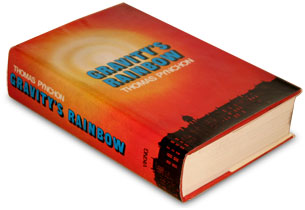Pynchon Wiki: Gravity's Rainbow
To become a contributor/editor, Create an account.
This is the wiki for Thomas Pynchon's Gravity's Rainbow. Besides using the Alphabetical Index and the page-by-page annotation, you can also take a look at Gravity's Rainbow covers, read the reviews, or entertain some theories on the source of the title.
Great article in Wired about Gravity's Rainbow on the occasion of the 50th anniversary of its publication. Check it out!
Review of Weisenburger's 2nd ed. of A Gravity's Rainbow Companion
Professor Don Larrson, he of the Companion's Companion to Gravity's Rainbow (which was rolled into this wiki), reviews Steve Weisenburger's the second, revised edition of A Gravity’s Rainbow Companion: Sources and Contexts for Pynchon’s Novel. Read it....
Marc Getter - Designer & Illustrator
Marc Getter (1947-2008) illustrated and designed the original covers for Gravity's Rainbow, in 1972 (published in 1973). Read his bio, as well a pictures of Marc, his wife, and some of his watercolors from the 1990s.
Contents
How to Use this Wiki
There are two major ways to use this wiki. The first is the Gravity's Rainbow Alphabetical Index, used to keep track of the myriad characters, real and imagined, as well as events, arcana, and lots of other stuff. The second is the Spoiler-Free Annotations by Page, which allows the reader to look up and contribute allusions and references while reading the book, in a convenient and spoiler-free manner. These two sections are so far almost entirely different, but we're working on integrating them.
Apart from those, it's up to you.
Alphabetical Index
Information on the characters, events, and everything else in Gravity's Rainbow, organized alphabetically:
Page by Page Annotations
| 1 Beyond the Zero |
3-7, 7-16, 17-19, 20-29, 29-37, 37-42, 42-47, 47-53, 53-60, 60-71, 71-72, 72-83, 83-92, 92-113, 114-120, 120-136, 136-144, 145-154, 154-167, 167-174, 174-177 |
|---|---|
| 2 Un Perm' au Casino Herman Goering |
181-189, 189-205, 205-226, 226-236, 236-244, 244-249, 249-269, 269-278 |
| 3 In the Zone |
279-295, 295-314, 314-329, 329-336, 336-359, 359-371, 371-383, 383-390, 390-392, 392-397, 397-433, 433-447, 448-456, 457-468, 468-472, 473-482, 482-488, 488-491, 492-505, 505-518, 518-525, 525-532, 532-536, 537-548, 549-557, 557-563, 563-566, 567-577, 577-580, 580-591, 591-610, 610-616 |
| 4 The Counterforce |
617-626, 626-640, 640-655, 656-663, 663-673, 674-700, 700-706, 706-717, 717-724, 724-733, 733-735, 735-760 |
Character Map
**Contains Spoilers**
A character map showing how most of the major characters connect together (PDF).
Pynchon Wiki Help and Contributor Guidelines
Click here for help with editing and creating pages.
We have a few conventions we ask that you follow:
- When creating a new page, first check to make sure a page/article about what you want to write about hasn't already been created, by checking the list of all Wiki pages on Pynchon Wiki. If a page already exists, please modify that one.
- When creating a new page, if its information pertains to one (and only one) specific Pynchon novel, please categorize it with the appropriate identifier. For example, a page pertaining to Gravity's Rainbow, should use the syntax
[[Category:GR]].
- To open a discussion on an individual listing of the Alpha Index, create one using the entry on Peter Tait as an example. Basically, give it a name that identifies the alpha listing (eg [[Name Discussion|DISCUSSION]]) and notice that the visible name will be "DISCUSSION" in full caps, so it stands out a bit.
External Links
- The Modern Word: Gravity's Rainbow
- The Fictional Woods - a Pynchon forum
- Zak Smith's Illustrations for Each Page of Gravity's Rainbow
- A companion's companion to Gravity's Rainbow
- Pynchonoid Blog
- Pomona Gravity's Rainbow page
- Wikipedia Gravity's Rainbow page
- Chinese site which includes full text of the novel
- Collected Annotations to Gravity's Rainbow
- "Chaos and the Psychological Symbolism of the Tarot" by Gerald Schueler, PhD
- Songs written by Pynchon for Gravity's Rainbow. Music composed and performed by the collaborative band, The Thomas Pynchon Fake Book
Featured Article
"Rocket Power" a review of Gravity's Rainbow by Richard Poirier — One of the best!
"At thirty-six, Pynchon has established himself as a novelist of major historical importance. More than any other living writer, including Norman Mailer, he has caught the inward movements of our time in outward manifestations of art and technology so that in being historical he must also be marvelously exorbitant. It is probable that he would not like being called "historical." In Gravity's Rainbow, even more than in his previous work, history -- as Norman 0. Brown proposed in Life Against Death -- seen as a form of neurosis, a record of the progressive attempt to impose the human will upon the movements of time. Even the very recording of history is such an effort. History-making man is Faustian man. But while this book offers such Faustian types as a rocket genius named Captain Blicero and a Pavlovian behaviorist named Edward Pointsman, it is evident that they are slaves to the systems they think they master."
Marc Getter, Designer & Illustrator of the original Gravity's Rainbow CoverLast year, Tim Ware decided to find out more about Marc Getter who did the original Gravity's Rainbow cover design and illustration — the city silhouette with sunburst sky. He wanted to ask Marc about the process of creating that beautiful cover. unfortunately, Marc had died in 2008. However, Tim was able to get in contact with his wife, Linda, who really wanted to assist in creating a page about Marc for the Gravity's Rainbow wiki. Read about Marc Getter and view his wonderful paintings.
At Sixes and Sevens
To be "at sixes and sevens" is an English phrase and idiom, common in the United Kingdom. It is used to describe a state of confusion or disarray.
"He'd never told her, he avoided telling himself, but that was the measure of his faith, as this seventh Christmas of the War came wheeling in another charge at his skinny, shivering flank..." - Gravity's Rainbow, p.126
"A miscount" - Steven C. Weisenburger, A Gravity's Rainbow Companion
Um, not so fast there, Steve...
Gallery
Below are some of the images you will find on Pynchon Wiki.Miss-rheingold.jpg
WikiAdmin
20:06, 4 July 2021
96 KB
Poirier-Review-GR-Illu...
WikiAdmin
16:50, 28 August 2017
283 KB
Vat 69.jpeg
Froberger
12:36, 10 March 2016
8 KB
Ein Volk, Ein Reich, E...
Froberger
10:30, 5 March 2016
24 KB
Ruptured Duck.jpeg
Froberger
09:43, 28 February 2016
75 KB
Ike Jacket.jpeg
Froberger
15:17, 24 February 2016
8 KB
Time-March-5-1973-cove...
WikiAdmin
13:02, 4 January 2015
86 KB
Tchitcherine.jpg
WikiAdmin
16:05, 16 October 2013
269 KB
Gravitys-rainbow-cover...
WikiAdmin
14:16, 5 December 2011
75 KB
Marc-getter.jpg
WikiAdmin
13:49, 5 December 2011
70 KB
Marc-Linda-Getter.jpg
WikiAdmin
17:50, 4 December 2011
48 KB
Getter vermont.jpg
WikiAdmin
17:42, 4 December 2011
158 KB
Getter tree-at-cooper-...
WikiAdmin
17:41, 4 December 2011
129 KB
Getter house-and-large...
WikiAdmin
17:41, 4 December 2011
138 KB
Getter broken-house.jpg
WikiAdmin
17:40, 4 December 2011
182 KB
Getter chimney.jpg
WikiAdmin
17:39, 4 December 2011
169 KB
Marc-getter sketching.jpg
WikiAdmin
17:29, 4 December 2011
47 KB
Slim-pickens.jpg
WikiAdmin
15:42, 6 April 2008
27 KB
Miraculous medal back.jpg
WikiAdmin
22:48, 13 December 2007
5 KB
Miraculous medal.jpg
WikiAdmin
22:47, 13 December 2007
8 KB
GR Greek2.jpg
Ctsats
06:40, 22 September 2007
6 KB
Pynchon-simpsons.jpg
WikiAdmin
23:46, 9 May 2007
26 KB
Freaks.jpg
WikiAdmin
22:59, 11 March 2007
46 KB
Cuddles.jpg
WikiAdmin
22:56, 11 March 2007
13 KB
Blowout.jpg
WikiAdmin
10:12, 11 March 2007
11 KB
St Just.jpg
WikiAdmin
10:07, 11 March 2007
17 KB
Blackhawk.jpg
WikiAdmin
08:37, 11 March 2007
20 KB
Submariner-1.jpg
WikiAdmin
08:34, 11 March 2007
125 KB
Nymphenburg.jpg
WikiAdmin
08:30, 11 March 2007
19 KB
Wuxtry.jpg
WikiAdmin
08:24, 11 March 2007
24 KB
Jekyll-hyde-bergman.jpg
WikiAdmin
17:44, 10 March 2007
17 KB
Dragon-lady.jpg
WikiAdmin
17:22, 10 March 2007
83 KB
Mae-west.jpg
WikiAdmin
17:05, 10 March 2007
13 KB
Saboteur.jpg
WikiAdmin
15:53, 10 March 2007
25 KB
Shadow-waltz.jpg
WikiAdmin
15:12, 10 March 2007
15 KB
Michael-Faraday.jpg
WikiAdmin
12:45, 10 March 2007
38 KB
Silver-streak-train-po...
WikiAdmin
12:40, 10 March 2007
34 KB
Silver-streak-comics.jpg
WikiAdmin
12:38, 10 March 2007
54 KB
Attila-the-hun.jpg
WikiAdmin
12:03, 10 March 2007
18 KB
Rottwang.jpg
WikiAdmin
11:59, 10 March 2007
42 KB
Looney-tunes.jpg
WikiAdmin
23:05, 7 March 2007
32 KB
Fay-wray2.jpg
WikiAdmin
22:44, 7 March 2007
34 KB
William-bendix.jpg
WikiAdmin
22:40, 7 March 2007
37 KB
Metropolis.jpg
WikiAdmin
22:28, 7 March 2007
48 KB
Justus-liebig.jpg
WikiAdmin
22:09, 7 March 2007
10 KB
Llandudno.jpg
WikiAdmin
21:39, 7 March 2007
46 KB
Shirley-temple.jpg
WikiAdmin
22:12, 6 March 2007
12 KB
Buffalo-bayou.jpg
WikiAdmin
22:05, 6 March 2007
66 KB
Carole-lombard.jpg
WikiAdmin
21:45, 6 March 2007
12 KB
Irving-berlin.jpg
WikiAdmin
21:44, 6 March 2007
11 KB
Thanks, and enjoy...




















































